This year’s Golden Globes have been a hot topic, not really because of who won and who lost, but because of what most attendees were wearing. In solidarity with the Time’s Up movement, most of the attendees wore black to advocate for gender equality in the workplace and denounce sexual assault and harassment. All except for a handful of women wore variations of black outfits, some donning jewels, embellishments, textures and trousers to express their individual style while adhering to the unofficial dress code. Many of the men in attendance also wore all black to support the movement, and Reese Witherspoon designed the Time’s Up pins that many of the attendees wore.
While the gesture could have fallen flat, given that the host was male and many of the categories lacked female representation — as Natalie Portman coolly pointed out when announcing the “all-male nominees” for Best Director C the dress code was not the only thing sparking conversation about the movement. Host Seth Meyers addressed “the elephant not in the room” when he briefly spoke about Harvey Weinstein. He set the tone of the night when he said, “People in this room worked really hard to get here, but it’s clear now more than ever before that the women had to work even harder.”
Many of the winners, like Sterling K. Brown, who took home the Best Actor in a Television Drama award, took their speeches as a chance to discuss social issues in Hollywood. Oprah Winfrey, the first black woman to receive the Cecil B. DeMille award, gave an inspiring speech discussing the Time’s Up and #Metoo movements, saying, “For too long women have not been heard or believed if they dared to speak their truth to the power of those men. But their time is up.”
With these powerful speeches, the dress code — which some people first argued was limiting and superficial — gained new significance. Attendees not only spoke about gender inequality in Hollywood, but took the opportunity to represent the movement in its entirety, which encapsulates women of all backgrounds, races, social classes and careers. Many attendees, like Emma Watson, brought gender and racial justice activists as their guests. Watson’s guest, Marai Larasi, is the executive director of Imkaan, an organization in the UK which is dedicated to protecting minority women and girls from violence.
This is not to say, however, that attendees of the awards who didn’t dress in black were in the wrong. Perhaps the most talked about actress who didn’t wear black was Blanca Blanco, who wore a red floor-length gown. While it was wonderful to see the solidarity of those all dressed in black, those who opted out of wearing black were well within their rights to do so, and shouldn’t be criticized.
Many social media users have accused Blanco of being part of the problem because she wore a revealing dress that “supports sexual misconduct.” Such a claim misses the movement’s point entirely. There is no such thing as clothes that “support” sexual misconduct. Saying so reeks of hypocrisy and is akin to asking sexual violence victims what they were wearing when they were assaulted. In response to the criticism Blanco said, “I applaud and stand by the courageous actresses that continue to break the circle of abuse through their actions and their style choice.”
Though the unofficial dress code at the Golden Globes does not eradicate social injustice — obviously — it is representative of a change in the narrative. At a time when scores of women finally feel empowered enough to share their stories, emphasis on the Time’s Up movement at the Globes was more than appropriate.


